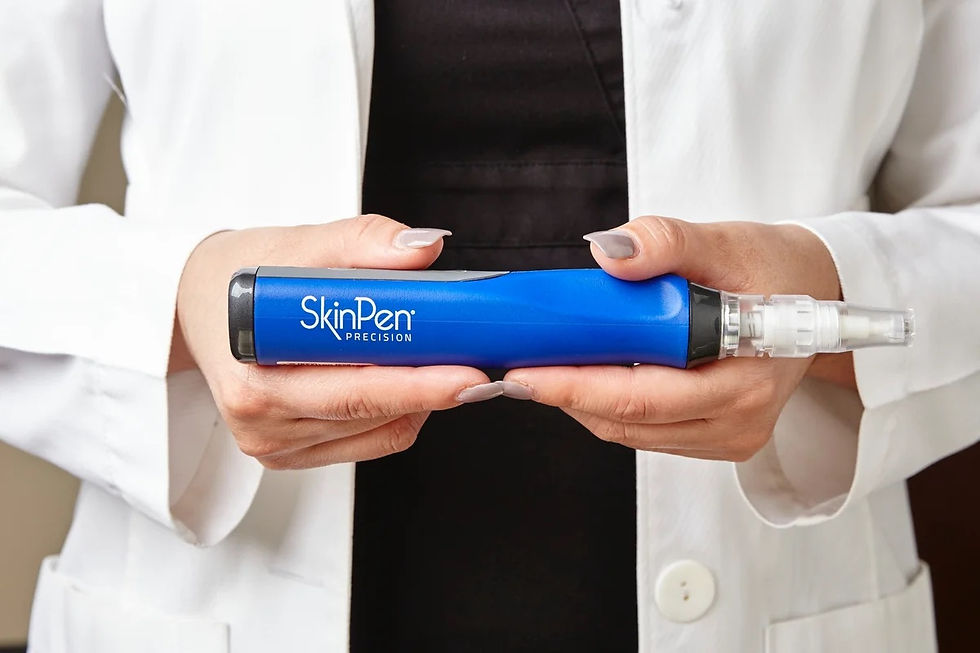
Understanding the Different Types of Acne—and How to Treat Them
- erynbeaupre
- Jun 11
- 3 min read
Coastal Aesthetics | Anacortes, WA
Acne is one of the most common skin conditions, affecting up to 85% of people between ages 12 and 24—and it’s not just a teenage problem (Zaenglein et al., 2016). Understanding the type of acne you’re dealing with is the first step in building a personalized, effective treatment plan. At Coastal Aesthetics, our acne-certified professionals offer targeted treatments for every acne type—from occasional congestion to deep cystic breakouts.
1. Comedonal Acne: Blackheads and Whiteheads
This is the most common form of non-inflammatory acne and includes:
Blackheads (open comedones): Clogged pores exposed to air, turning dark through oxidation.
Whiteheads (closed comedones): Clogged pores that remain sealed under the skin.
Treatment Approach:
✔️ Topicals with salicylic acid or alpha hydroxy acids to promote exfoliation
✔️ Consistent cleansing to reduce buildup of oil and dead skin cells
✔️ In-office treatments such as light chemical peels and pore extractions
✔️ Daily use of non-comedogenic, acne-safe skincare products
Salicylic acid is a first-line treatment due to its comedolytic properties (Zaenglein et al., 2016).
2. Papules and Pustules: Inflamed Breakouts
These lesions are characterized by inflammation.
Papules: Red, tender bumps without visible pus.
Pustules: Inflamed lesions with a white or yellow center.
Treatment Approach:
✔️ Benzoyl peroxide to reduce C. acnes bacteria and inflammation
✔️ Topical retinoids (like adapalene) to prevent clogged pores
✔️ In-office LED light therapy or peels to support skin healing
✔️ Customized medical-grade skincare to calm inflammation
Benzoyl peroxide remains a gold standard for treating inflammatory lesions due to its antibacterial and keratolytic effects (Thiboutot et al., 2021).
3. Nodular Acne: Painful, Deep Lesions
Nodules are large, firm, and often painful lesions that develop deep within the skin. These do not contain pus and may take weeks to resolve.
Treatment Approach:
✔️ Evaluation for prescription-strength treatments like oral antibiotics or spironolactone
✔️ Steroid injections for immediate relief of painful nodules
✔️ Supportive home care with barrier-repair ingredients
✔️ Medium-depth chemical peels for long-term management
For moderate to severe nodular acne, systemic therapies are often necessary (Zaenglein et al., 2016).
4. Cystic Acne: Severe, Hormonal Breakouts
Cystic acne includes deep, pus-filled lesions and is often driven by hormonal fluctuations. It carries a higher risk of scarring.
Treatment Approach:
✔️ Hormonal therapies (oral contraceptives or anti-androgens)
✔️ Medical evaluation for isotretinoin (Accutane) when indicated
✔️ RF microneedling after inflammation has resolved to reduce scarring
✔️ Acne-safe skincare that supports barrier health and reduces inflammation
Hormonal therapy is effective for many women with resistant acne, especially when it flares cyclically (Del Rosso, 2015).
5. Fungal Acne (Malassezia Folliculitis): Not Really Acne!
This acne-like condition is caused by yeast, not bacteria, and often appears as itchy, uniform bumps on the chest, back, or face.
Treatment Approach:
✔️ Topical or oral antifungals
✔️ Skincare adjustments to reduce moisture and oil retention
✔️ Diagnosis confirmed through professional evaluation
Malassezia folliculitis is commonly misdiagnosed, leading to ineffective treatment with standard acne products (Rubenstein & Malerich, 2014).
Our Evidence-Based Acne Treatment Philosophy
At Coastal Aesthetics, we believe clear skin starts with clarity in diagnosis and clinical-level care. Whether you’re dealing with blackheads or painful cysts, our personalized acne protocols combine:
Board-certified NP and esthetician evaluation
Proven in-office treatments like the OxyVerve oxygenating facial, chemical peels, LED therapy, and RF microneedling
Medical-grade, acne-safe home skincare
Support every step of the way—from treatment to prevention
Schedule a Consultation Today
Let’s build a plan that works for your skin—not someone else’s. Book your consultation with one of our providers at Coastal Aesthetics and get the expert care your skin deserves.
References
Del Rosso, J. Q. (2015). Oral spironolactone in the management of acne vulgaris in adult females: Practical considerations for the clinician. The Journal of Clinical and Aesthetic Dermatology, 8(5), 37–50.
Rubenstein, R. M., & Malerich, S. A. (2014). Malassezia (Pityrosporum) folliculitis. Journal of Clinical and Aesthetic Dermatology, 7(3), 37–41.
Thiboutot, D. M., Dréno, B., Gollnick, H. P. M., Bettoli, V., Kang, S., Leyden, J. J., … & Tan, J. (2021). Practical management of acne for clinicians: An international consensus from the Global Alliance to Improve Outcomes in Acne. Journal of the American Academy of Dermatology, 84(1), 74–92. https://doi.org/10.1016/j.jaad.2020.06.045
Zaenglein, A. L., Pathy, A. L., Schlosser, B. J., Alikhan, A., Baldwin, H. E., Berson, D. S., … & Bhushan, R. (2016). Guidelines of care for the management of acne vulgaris. Journal of the American Academy of Dermatology, 74(5), 945–973.e33. https://doi.org/10.1016/j.jaad.2015.12.037



Comments